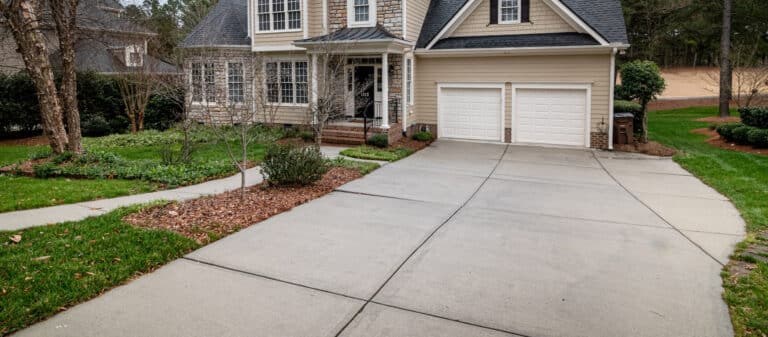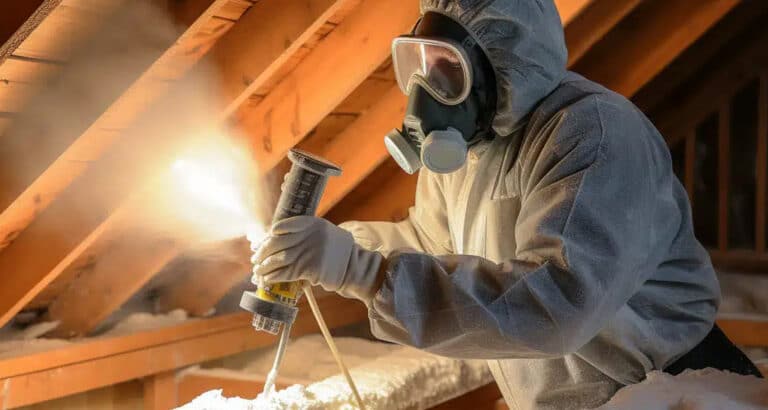Exterior walls can be a major source of heat loss in Northeast Pennsylvania, accounting for 15% to 25% of total winter heat loss.
In addition to preventing heat loss, insulating your exterior walls can also reduce seasonal allergens and pests that make nests within open wall cavities.
The best insulation for walls does not always mean the highest R-value, as Energy Star only recommends an R10 rating for uninsulated wood-frame walls in NEPA.
Instead, choosing the best insulation depends on accessibility, air sealing qualities, and long-term stability against moisture and mold.
This guide will help you decide which insulation is best for your exterior walls in NEPA, based on these factors, as well as affordability and other qualities.
1. Spray Foam Insulation
- R-value: ~R-6.0 to R-7.0 per inch
Spray foam insulation is the best insulation material on the market in terms of coverage and R-value.
Spray foam can be installed behind existing drywall and siding and provides air sealing qualities that other forms of insulation lack. Spray foam naturally resists moisture and pests, lasting up to 100 years or more under ideal conditions.
Understanding the Technology
Spray foam insulation is created by mixing two materials—polyol resin and isocyanate—that react and expand into a foam when combined. This foam can then be sprayed directly onto the surface needing insulation, rapidly expanding and hardening to form a protective barrier.
Why Choose Spray Foam?
Besides the obvious energy-saving benefits of superior insulation, spray foam insulation prevents water seepage, keeping your home dry and mold-free.
Its ability to fill and seal nooks and crannies also reduces the amount of dust and allergens entering your home, contributing to a healthier living environment.
Spray foam insulation is ideal for new homes and renovations. Otherwise, the wall may need to be knocked down or an access point created to allow the insulation to be sprayed.
2. Blown-In Fiberglass Insulation
- R-value: ~R-2.2 to R-2.9 per inch
For existing homes that desire a less-intrusive insulating material, blown-in insulation is an excellent choice.
Blown-in fiberglass uses a machine to distribute loose-fill fiberglass material throughout your attic, providing comprehensive coverage and significantly reducing heat transfer.
What Makes Blown-In Fiberglass Effective?
Fiberglass is an exceptional insulator because it traps pockets of air, slowing down the transfer of heat. When blown into an attic or wall cavity, it fills the entire space, leaving no gaps or seams that could lead to energy loss.
Why Choose Blown-In Fiberglass?
Blown-in fiberglass is also resistant to fire, pests, and mold, making it a safe and durable choice. Moreover, because it can be installed quickly and easily, it minimizes disruption to your home or business.
3. Blown Cellulose Insulation
- R-value: ~R-3.1 to R-3.8 per inch
Blown cellulose insulation is an eco-friendly alternative to fiberglass that can insulate attics and walls. Made from recycled paper treated with fire-retardant chemicals, cellulose offers excellent thermal performance while contributing to environmental sustainability.
The Process and Benefits of Blown Cellulose
The installation process for blown cellulose insulation is similar to that of blown-in fiberglass. Cellulose is blown into the attic, creating a dense, uniform layer of insulation. Because cellulose is denser than fiberglass, it often provides even better thermal and acoustic insulation. At EnergySmart, blown-in insulation can be installed through a hole drilled in your wall and siding, allowing us to install the material without replacing the wall.
Why Choose Blown Cellulose?
Choosing blown cellulose insulation means you’re opting for a green, energy-efficient solution. If you’re interested in making your home or business more sustainable, this could be the insulation method for you.
4. Fiberglass Batt Insulation
- R-value: ~R-2.9 to R-3.8 per inch
Fiberglass batt insulation is one of the most commonly used types of insulation for walls and attics. These pre-cut panels are designed to fit snugly between wall studs and floor joists, making them a quick and easy solution for many insulation needs.
Understanding Fiberglass Batt Insulation
Fiberglass batts are essentially blankets of woven glass fibers. They’re available in different thicknesses to suit different requirements, and their flexibility allows them to fit around obstacles like pipes and wiring.
Why Choose Fiberglass Batt Insulation?
Although fiberglass batts may not provide the same high level of thermal resistance as spray foam, they’re a more cost-effective option that can still significantly reduce your energy costs. They’re also non-combustible, contributing to a safer home or business environment.
5. Injection Foam Insulation
- R-value: ~R-4.0 to R-4.5 per inch
Injection foam insulation is an ideal choice for enclosed existing walls or open wall cavities. Installers inject foam into the wall cavity, where it expands and hardens to provide high thermal resistance and excellent air sealing.
The Power of Injection Foam
Injection foam is particularly good at filling voids and sealing around obstacles, making it an excellent choice for irregularly shaped areas or spaces with lots of penetrations.
Why Choose Injection Foam?
This type of insulation is especially valuable in retrofit applications where it’s important to improve energy efficiency without causing major disruption to the structure. It also offers excellent soundproofing benefits, helping to create a quieter and more comfortable living or working environment.
6. Air Sealing
While not technically a type of insulation, air sealing is a critical component of any insulation strategy. By sealing the small cracks, gaps, and crevices that allow air to leak into or out of a building, air sealing can significantly enhance the effectiveness of other insulation types.
The Importance of Air Sealing
In an uninsulated or poorly insulated home, air leaks can be responsible for significant heat loss. By sealing these leaks, you can significantly reduce your heating and cooling costs and make your home more comfortable year-round.
Why Choose Air Sealing?
Air sealing is typically a very cost-effective way to improve your home’s energy efficiency. Plus, by reducing drafts and cold spots, it can also make your home more comfortable to live in.
Signs Your Existing Walls Are Underinsulated
While exterior wall insulation is not the most common insulation project, there may be signs that it’s time to upgrade or insulate your walls, especially if you’re suffering from poor energy performance after insulating your attic and basement.
- Noticeable drafts near outlets or switches
- Uneven temperatures between floors
- High energy bills despite newer HVAC equipment
- Cold or hot exterior walls, depending on season
- Rooms that are harder to heat or cool
These symptoms often indicate empty or poorly insulated wall cavities. Because the problem is hidden, many homeowners don’t realize how much energy is being lost until an inspection or thermal scan reveals it.
Benefits of Insulating Behind Existing Walls
Insulating exterior walls may seem like overkill to some people, but insulated walls can lead to several benefits, including:
- Lower heating and cooling costs
- Even temperature distribution–no more drafts
- Fewer allergy symptoms
- Fewer pests and entry points for pests
In cities like Scranton and Wilkes-Barre in Northeastern Pennsylvania, where the weather ranges from hot summers to cold, snowy winters, your insulation greatly impacts your utility costs and comfort.
At EnergySmart, we have a wealth of experience and expertise to provide a range of insulation solutions, including spray foam, blown-in fiberglass, cellulose, and more.
Whether you’re a homeowner or a business, our services are tailored to provide the best insulation options to keep your property well-insulated and energy-efficient. Furthermore, we understand that every property and its requirements are unique, so we offer personalized services tailored to your needs.
FAQs
What is spray foam insulation and how does it work?
Spray foam insulation is a highly effective and versatile type of insulation that is applied as a liquid and expands into a foam when sprayed. It is made by mixing two components: polyol resin and isocyanate. When these components react, they form a foam that quickly expands, filling gaps, cracks, and voids, creating a seamless and airtight barrier.
Three important features of spray foam insulation:
- Exceptional thermal performance
- Provides superior air sealing capabilities
- Expands to reach hard-to-reach spaces for comprehensive coverage
What is blown-in fiberglass insulation and how is it installed?
Blown-in fiberglass insulation is a popular choice for insulating attics and wall cavities. It consists of loose-fill fiberglass material that is blown into the designated area using a special machine. This installation method ensures that the insulation evenly covers the space, providing effective thermal resistance and reducing heat transfer.
How does blown cellulose insulation contribute to a sustainable environment?
Blown cellulose insulation is an eco-friendly option made from recycled paper treated with fire-retardant chemicals. The cellulose fibers create a dense, uniform layer of insulation when blown into attics or wall cavities, offering excellent thermal performance and acoustic insulation while reducing energy consumption.
How does injection foam insulation benefit existing walls?
Injection foam insulation is an excellent option for insulating existing walls, especially in retrofit applications. Installers inject the foam into wall cavities, where it expands and hardens, providing high thermal resistance and efficient air sealing. It can also improve soundproofing properties and create a more comfortable indoor environment.
What Insulation Has the Highest R-Value for Walls?
Closed-cell spray foam insulation has the highest R-value per inch of any wall insulation, typically around R-6 to R-7 per inch. In addition to its insulating value, it also creates an air and moisture barrier, which significantly improves real-world performance compared to insulation that only slows heat transfer but does not stop air leakage.
Is Blown-In Insulation a Good Choice for Wall Cavities?
Yes. Blown-in fiberglass and blown cellulose are both excellent options for wall cavities, especially in finished homes. They can be installed with minimal wall access, provide more complete coverage than batts, and improve comfort by reducing drafts and temperature swings. Blown cellulose is often preferred when additional sound dampening or air resistance is needed.
Is Spray Foam Insulation Worth the Higher Cost?
In many cases, yes. While spray foam insulation has a higher upfront cost, it often delivers lower long-term energy bills due to its superior air sealing and thermal performance. Homes insulated with spray foam frequently experience fewer drafts, more consistent indoor temperatures, and reduced HVAC strain, which can offset the initial investment over time.
Which Insulation Is Best for Soundproofing Walls?
Dense insulation materials perform best for sound control. Blown cellulose and injection foam are particularly effective because they fill cavities tightly and reduce air movement, which is a major contributor to noise transmission. These materials are commonly used in shared walls, home offices, and living spaces where noise reduction is a priority.










